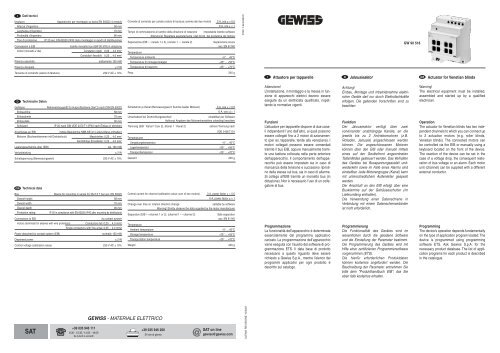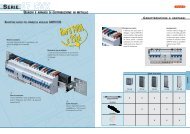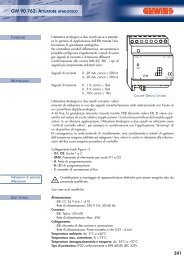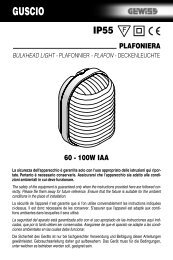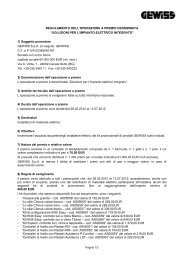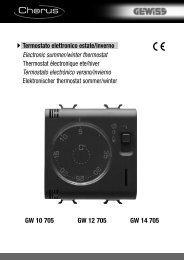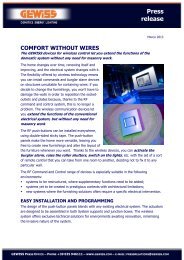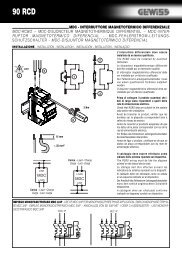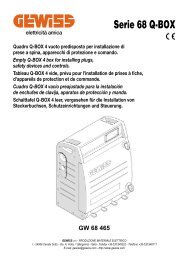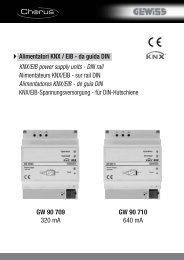GEWISS - MATERIALE ELETTRICO
GEWISS - MATERIALE ELETTRICO
GEWISS - MATERIALE ELETTRICO
You also want an ePaper? Increase the reach of your titles
YUMPU automatically turns print PDFs into web optimized ePapers that Google loves.
I Dati tecnici<br />
Involucro<br />
Altezza d’ingombro<br />
Larghezza d’ingombro<br />
Profondità d’ingombro<br />
Tipo di protezione<br />
Connessioni a EIB<br />
Apparecchio per montaggio su barra EN 50022 (4 moduli)<br />
58 mm<br />
70 mm<br />
90 mm<br />
IP 20 sec. EN 60529 (IP40 dopo montaggio in quadri di distribuzione)<br />
tramite morsetto bus (GW 90 578) in dotazione<br />
Corrente di comando per canale (valore di taratura; somma dei due motori) 3 A, cos ϕ = 0,5<br />
6 A, cos ϕ = 1<br />
Tempo di commutazione al cambio della direzione di rotazione impostabile tramite software<br />
Attenzione! Rispettare assolutamente i dati forniti dal produttore del motore<br />
Separazione (EIB ↔ canale 1 o 2), (canale 1 ↔ canale 2)<br />
Separazione sicura<br />
sec. EN 61140<br />
COD. 7.42.6.833.5<br />
GW 90 518<br />
motori (morsetti a vite) Conduttori rigidi: 0,25 ... 4,0 mm 2<br />
Conduttori flessibili: 0,25 ... 4,0 mm 2<br />
Potenza assorbita<br />
solitamente 150 mW<br />
Potenza dissipata<br />
≤2 W<br />
Temperature<br />
Temperatura ambiente –5° ... 45°C<br />
Temperatura di immagazzinaggio<br />
Temperatura di trasporto<br />
–25° ... +55°C<br />
–25° ... +70°C<br />
Tensione di comando (valore di taratura) 230 V AC ± 10%<br />
Peso<br />
245 g<br />
Attuatore per tapparelle<br />
Jalousieaktor<br />
I D GB<br />
Actuator for Venetian blinds<br />
D Technische Daten<br />
Gehäuse Reiheneinbaugerät für Hutprofilschiene 35x7,5 nach DIN EN 50022<br />
Einbauhöhe<br />
58 mm<br />
Einbaubreite<br />
70 mm<br />
Einbautiefe<br />
90 mm<br />
Schutzart<br />
IP 20 nach DIN VDE 0470 T1 (IP40 nach Einbau in Verteiler)<br />
Anschlüsse an EIB<br />
mittels Basklemme NBB-KB (im Lieferumfang enthalten)<br />
Motoren (Buchsenklemmen mit Drahtschutz) Massivleiter: 0,25 ... 4,0 mm 2<br />
feindrähtige Einzelleiter: 0,25 ... 4,0 mm 2<br />
Leistungsaufnahme über (EIB)<br />
typ. 150 mW<br />
Verlustleistung<br />
≤2 W<br />
Schaltspannung (Bemessungswert) 230 V AC ± 10%<br />
GB Technical data<br />
Box Device for mounting in series for 35x7.5 T bar acc. EN 50022<br />
Overall height<br />
58 mm<br />
Overall width<br />
70 mm<br />
Overall depth<br />
90 mm<br />
Protection rating<br />
IP 20 in compliance with EN 60529 (IP40 after mounting by distributors)<br />
Connections to EIB<br />
via contact system<br />
motors (terminals for sleeves with wire protection)<br />
Conductors full: 0,25 ... 4,0 mm2<br />
Single conductors with fine wires: 0,25 ... 4,0 mm2<br />
Power absorbed by contact system (EIB)<br />
normally 150 mW<br />
Dispersed power<br />
≤2 W<br />
Control voltage (calibration value) 230 V AC ± 10%<br />
Schaltstrom je Kanal (Bemessungswert; Summe beider Motoren) 3 A, cos ϕ = 0,5<br />
6 A, cos ϕj = 1<br />
Umschaltzeit bei Drehrichtungswechsel<br />
einstellbar per Software<br />
Achtung! Angaben des Motorenherstellers unbedingt beachten<br />
Trennung (EIB ´ Kanal 1 bzw. 2), (Kanal 1 ´ Kanal 2)<br />
sichere Trennung nach<br />
VDE 0106 T101<br />
Temperaturen<br />
Umgebungstemperatur –5° ... 45°C<br />
Lagertemperatur<br />
–25° ... +55°C<br />
Transporttemperatur<br />
–25° ... +70°C<br />
Gewicht<br />
245 g<br />
Control current for channel (calibration value; sum of two motors) 3 A, power factor ϕ = 0,5<br />
6 A, power factor ϕ = 1<br />
Change-over time on rotation direction change<br />
settable by software<br />
Warning! Strictly observe the data supplied by the motor manufacturer<br />
Separation (EIB ↔ channel 1 or 2), (channel 1 ↔ channel 2)<br />
Safe separation<br />
acc. EN 61140<br />
Temperature<br />
Ambient temperature –5° ... 45°C<br />
Storage temperature<br />
Transportation temperature<br />
Weight<br />
–25° ... +55°C<br />
–25° ... +70°C<br />
245 g<br />
Attenzione!<br />
L’installazione, il montaggio e la messa in funzione<br />
di apparecchi elettrici devono essere<br />
eseguite da un elettricista qualificato, rispettando<br />
le normative vigenti.<br />
Funzioni<br />
L’attuatore per tapparelle dispone di due canali<br />
indipendenti l’uno dall’altro, ai quali possono<br />
essere collegati fino a 2 motori di azionamento<br />
(per es. tapparelle, tende alla veneziana). I<br />
motori collegati possono essere comandati<br />
tramite il bus EIB, oppure manualmente tramite<br />
una tastiera collocata nella parte anteriore<br />
dell’apparecchio. Il comportamento dell’apparecchio<br />
può essere impostato sia in caso di<br />
mancanza della tensione e successivo ripristino<br />
della stessa sul bus, sia in caso di allarme.<br />
Si collega all’EIB tramite un morsetto bus (in<br />
dotazione). Non è necessario l’uso di un collegatore<br />
al bus.<br />
Programmazione<br />
La funzionalità dell’apparecchio è determinata<br />
essenzialmente dal programma applicativo<br />
caricato. La programmazione dell’apparecchio<br />
viene eseguita con l’ausilio del software di programmazione<br />
ETS. Il data base di prodotto<br />
necessario a questo riguardo deve essere<br />
richiesto a Gewiss S.p.A., mentre l’elenco dei<br />
programmi applicativi per ogni prodotto è<br />
descritto sul catalogo.<br />
Achtung!<br />
Einbau, Montage und Inbetriebnahme elektrischer<br />
Geräte darf nur durch Elektrofachkräfte<br />
erfolgen. Die geltenden Vorschriften sind zu<br />
beachten.<br />
Funktion<br />
Der Jalousieaktor verfügt über zwei<br />
voneinander unabhängige Kanäle, an die<br />
jeweils bis zu 2 Antriebsmotoren (z.B.<br />
Rolladen, Jalousie) angeschlossen werden<br />
können. Die angeschlossenen Motoren<br />
können über den EIB oder manuell mittels<br />
eines auf der Gerätefront angeordneten<br />
Tastenfeldes gesteuert werden. Das Verhalten<br />
des Gerätes bei Busspannungsausfall undwiederkehr<br />
sowie im Falle eines Alarms sind<br />
einstellbar. Jede Motorengruppe (Kanal) kann<br />
mit unterschiedlichem Außenleiter gespeist<br />
werden.<br />
Der Anschluß an den EIB erfolgt über eine<br />
Busklemme auf der Gehäuseschulter (im<br />
Lieferumfang enthalten).<br />
Die Verwendung einer Datenschiene in<br />
Verbindung mit einem Datenschienverbinder<br />
ist nicht erforderlich.<br />
Programmierung<br />
Die Funktionalität des Gerätes wird im<br />
wesentlichen durch die geladene Software<br />
und die Einstellung der Parameter bestimmt.<br />
Die Programmierung des Gerätes wird mit<br />
Hilfe einer zertifizierten Programmiersoftware<br />
vorgenommen (ETS).<br />
Die hierfür erforderlichen Produktdaten<br />
können kostenlos angefordert werden. Die<br />
Beschreibung der Parameter entnehmen Sie<br />
bitte dem "Produkthandbuch EIB"; das Sie<br />
eben falls kostenlos erhalten.<br />
Warning!<br />
The electrical equipment must be installed,<br />
assembled and started up by a qualified<br />
electrician.<br />
Operation<br />
The actuator for Venetian blinds has two independent<br />
channels to which you can connect up<br />
to 2 actuation motors (e.g. roller blinds,<br />
Venetian blinds). The connected motors can<br />
be controlled via the EIB or manually using a<br />
keyboard located on the front of the device.<br />
The reaction of the device can be set in the<br />
case of a voltage drop, the consequent restoration<br />
of bus voltage or an alarm. Each motor<br />
unit (channel) can be supplied with a different<br />
external conductor.<br />
Programming<br />
The device’s operation depends fundamentally<br />
on the type of application program loaded. The<br />
device is programmed using programming<br />
software ETS. Ask Gewiss S.p.A. for the<br />
necessary product database. The list of application<br />
programs for each product is described<br />
in the catalogue.<br />
SAT<br />
+39 035 946 111<br />
8.30 - 12.30 / 14.00 - 18.00<br />
da lunedì a venerdì<br />
<strong>GEWISS</strong> - <strong>MATERIALE</strong> <strong>ELETTRICO</strong><br />
+39 035 946 260<br />
24 ore al giorno<br />
SAT on line<br />
@ gewiss@gewiss.com<br />
ULTIMA REVISIONE 10/2007
I SCHEMA DEI COLLEGAMENTI D ANSCHLUßBILD GB CONNECTION I<br />
Elementi di azionamento e indicatori<br />
A<br />
B<br />
C<br />
D<br />
L<br />
Ch1<br />
(K1)<br />
Motore 1<br />
Motor 1<br />
Motor 1<br />
Down Up<br />
Motore 2<br />
Motor 2<br />
Motor 2<br />
Down Up<br />
E<br />
F<br />
A: Tasto di programmazione<br />
L’attivazione del tasto di programmazione comunica al software di messa in<br />
servizio (ETS) che l’apparecchio è pronto per la programmazione dell’indirizzo<br />
fisico. Sull’apparecchio questa condizione è segnalata dal LED rosso (B) attivo<br />
(=acceso). Azionando il tasto di programmazione è anche possibile verificare se<br />
l’apparecchio è alimentato con la tensione del bus oppure no. Per spegnere il<br />
LED, premere nuovamente il tasto.<br />
B: LED rosso<br />
LED attivo (=acceso): è stato premuto il tasto di programmazione (A). Dopo<br />
l’esecuzione della procedura di programmazione, il LED si spegne<br />
automaticamente. Tramite l’ETS questo LED può essere attivato e disattivato in<br />
modo mirato. E’ inoltre possibile un’identificazione dell’apparecchio<br />
(correlazione indirizzo fisico/apparecchio).<br />
C-D: Posizione preferenziale 1 (2)<br />
Richiamo di una posizione preferenziale impostabile tramite software: su, giù,<br />
posizione (direzione di funzionamento + regolazione lamelle).<br />
E: ON/OFF automatico<br />
Attivazione e disattivazione automatica della protezione contro il sole<br />
(= il funzionamento dipende dal valore dell’oggetto del sensore “luminosità” e dai<br />
relativi parametri impostati).<br />
F: Canale 1 (2) su/giù<br />
Tasti per l’azionamento manuale dei motori collegati ai relativi canali (tasto<br />
superiore: senso di azionamento: su; tasto inferiore: senso di azionamento: giù).<br />
Può essere attivato sia il funzionamento continuo (pressione lunga), sia il<br />
funzionamento a scatti (pressione breve).<br />
Note importanti<br />
Prima della messa in funzione dell’attuatore per tapparelle è necessario assicurarsi che gli interruttori di finecorsa dei motori collegati siano stati regolati<br />
correttamente. La mancata osservanza della suddetta norma può causare danni all’impianto! Non è garantito che, disattivando la tensione del bus, si possa intervenire<br />
senza pericoli sugli attuatori di comando! Questo è motivato dal fatto che la posizione di comando dei relè permane, inoltre può sempre essere presente tensione di<br />
carico sui morsetti. Devono essere assolutamente rispettate le norme di sicurezza ed in particolare quanto prescritto dalla EN 50110.<br />
D<br />
Anzeige- und Bedienelemente<br />
L Down Up Down Up<br />
Motore 1<br />
Motor 1<br />
Motor 1<br />
Motore 2<br />
Motor 2<br />
Motor 2<br />
I SCHEMA DIMENSIONALE D MAßBILD GB DIMENSIONAL DRAWING<br />
Ch2<br />
(K2)<br />
A: Programmiertaste<br />
Durch Betätigen der Programmiertaste wird der Inbetriebnahmesoftware (z.B.<br />
ETS) mitgeteilt, daß dieses Gerät zur Programmierung der physikalischen<br />
Adresse bereit ist. Am Gerät wird dies über die aktive rote LED (B) (= leuchtet)<br />
angezeigt. Durch Betätigen der Programmiertaste kann auch überprüft werden,<br />
ob die Busspannung am Gerät anliegt oder nicht. Nochmaliges Betätigen<br />
schaltet die LED wieder aus.<br />
B: rote LED<br />
LED aktiv (=leuchtet): Programmiertaste (A) ist betätigt worden. Sie wird nach<br />
erfolgreichem Programmiervorgang selbsttätig wieder ausgeschaltet. Mittels der<br />
ETS kann man diese Leuchtdiode auch gezielt ein- und ausschalten. Darüber ist<br />
dann eine Identifizierung des Gerätes möglich (Zuordnung physikalische<br />
Adresse/Gerät).<br />
C-D: Vorzugsstellung 1 (2)<br />
Abruf einer per Software eingestellten Vorzugsstellung: Auf, Ab, Position (=<br />
Fahrtrichtung + Lamellenwinkel)<br />
E: Automatik EIN/AUS<br />
Ein- bzw. Ausschalten der Sonnenschutzautomatik (= Betrieb abhängig vom<br />
Wert des Eingangsobjektes "Helligkeit" und den dazu eingestellten<br />
Parametern).<br />
F: Kanal 1 (2) Auf/Ab<br />
Tasten zur manuellen Bedienung der angeschlossenen Antriebsmotoren der<br />
jeweiligen Kanäle (obere Taste: Drehrichtung Antrieb: Auf; untere Tasten:<br />
Drehrichtung Antrieb: Ab). Es kann sowohl der Fahrbetrieb (lange Betätigung)<br />
als auch der Schrittbetrieb (kurze Betätigung) aktiviert werden.<br />
1.5<br />
58<br />
Wichtige Hinweise<br />
Vor Inbetriebnahme des Jalousieaktors muß sichergestellt sein, daß die Endschalter der angeschlossenen Motoren der Anlage entsprechend justiert worden sind.<br />
Nicht Beachten kann zu Schäden führen! Es ist nicht gewährleistet, daß bei Abschalten der Busspannung gefahrlos an Schaltaktoren gearbeitet werden kann! Es<br />
sind unbedingt die 5 Sicherheitsregeln zu beachten (Unfallverhütungsvorschrift VBG 4 und DIN VDE 0105 T1).<br />
44 6<br />
70<br />
GB<br />
Actuation elements and indicators<br />
45<br />
90<br />
A: Programming button<br />
When activated, the programming button communicates to the start-up software<br />
(e.g. ETS) that the device is ready to program the physical address. This<br />
condition is signalled by the active red LED (B) (=on). By pressing the<br />
programming button you can also check whether the device is supplied with the<br />
bus voltage. To switch off the LED, press the button again.<br />
B: Red LED<br />
LED active (=on): the programming button (A) has been pressed. Once the<br />
programming procedure is over, the LED turns off automatically. Using the ETS,<br />
this LED can be activated or disabled in a targeted way.You can also identify the<br />
device (correlation of physical address/device).<br />
C-D: Preferential position 1 (2)<br />
Reference to a preferential position settable by software: up, down, position<br />
(operating direction + slat angle).<br />
E: Automatic ON/OFF<br />
Automatic activation and disconnection of the sunshade (= the operation<br />
depends on the “brightness” value and the relative set parameters).<br />
F: Channel 1 (2) up/down<br />
Buttons for manually actuating connected motors of the relative channels (upper<br />
button: actuation of rotation direction: up; lower button: actuation of rotation<br />
direction: down). You can activate both continuous operation (button held down)<br />
and pulse operation (button pressed briefly).<br />
N.B.<br />
Before starting up the actuator for Venetian blinds, you need to make sure that the limit stop switches of the motors connected to the system have been<br />
regulated correctly. Failure to observe the above-mentioned regulation may cause serious damage! Even if you disconnect the bus voltage, it doesn’t necessarily<br />
mean that you can operate the control actuators without hazards! The 5 safety regulations must be strictly observed (Accident prevention regulations EN 50110).


